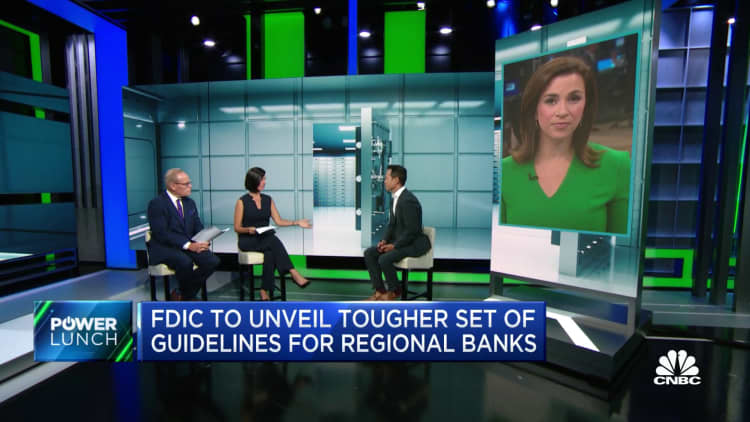Regional banks face another hit as regulators force them to raise debt levels
KEY POINTS
- U.S. regulators on Tuesday unveiled plans to force regional banks to issue debt and bolster their so-called living wills, steps meant to protect the public in the event of more failures.
- All American banks with at least $100 billion in assets would be subject to the new requirements, which resemble rules that apply to the world’s biggest banks.
- Impacted lenders will have to maintain long-term debt levels equal to 3.5% of average total assets or 6% of risk-weighted assets, whichever is higher, according to a fact sheet released Tuesday.
U.S. regulators on Tuesday unveiled plans to force regional banks to issue debt and bolster their so-called living wills, steps meant to protect the public in the event of more failures.
American banks with at least $100 billion in assets would be subject to the new requirements, which makes them hold a layer of long-term debt to absorb losses in the event of a government seizure, according to a joint notice from the Treasury Department, Office of the Comptroller of the Currency, Federal Reserve and Federal Deposit Insurance Corp.
The steps are part of regulators’ response to the regional banking crisis that flared up in March, ultimately claiming three institutions and damaging the earnings power of many others. In July, the agencies released the first salvo of expected changes, a sweeping set of proposals meant to heighten capital requirements and standardize risk models for the industry.
In their latest proposal, impacted lenders will have to maintain long-term debt levels equal to 3.5% of average total assets or 6% of risk-weighted assets, whichever is higher, according to a fact sheet released Tuesday by the FDIC. Banks will be discouraged from holding the debt of other lenders to reduce contagion risk, the regulator said.
Higher funding costs
The requirements will create “moderately higher funding costs” for regional banks, the agencies acknowledged. That could add to the industry’s earnings pressure after all three major ratings agencies have downgraded the credit ratings of some lenders this year.
Still, the industry will have three years to conform to the new rule once enacted, and many banks already hold acceptable forms of debt, according to the regulators. They estimated that regional banks already have roughly 75% of the debt they will ultimately need to hold.
The KBW Regional Banking Index, which has suffered deep losses this year, rose less than 1%.
Indeed, industry observers had expected these latest changes: FDIC Chairman Martin Gruenberg telegraphed his intentions earlier this month in a speech at the Brookings Institution.
Medium is the new big
Broadly, the proposal takes measures that apply to the biggest institutions — known in the industry as global systemically important banks, or GSIBs — down to the level of banks with at least $100 billion in assets. The moves were widely expected after the sudden collapse of Silicon Valley Bank in March jolted customers, regulators and executives, alerting them to emerging risks in the banking system.
That includes steps to raise levels of long-term debt held by banks, removing a loophole that allowed midsized banks to avoid the recognition of declines in bond holdings, and forcing banks to come up with more robust living wills, or resolution plans that would take effect in the event of a failure, Gruenberg said this month.
Regulators would also look at updating their own guidance on monitoring risks including high levels of uninsured deposits, as well as changes to deposit insurance pricing to discourage risky behavior, Gruenberg said in the Aug. 14 speech. The three banks seized by authorities this year all had relatively large amounts of uninsured deposits, which were a key factor in their failures.
What’s next for regionals?
Analysts have focused on the debt requirements because that is the most impactful change for bank shareholders. The point of raising debt levels is so that if regulators need to seize a midsized bank, there is a layer of capital ready to absorb losses before uninsured depositors are threatened, according to Gruenberg.
The move will force some lenders to either issue more corporate bonds or replace existing funding sources with more expensive forms of long-term debt, Morgan Stanley analysts led by Manan Gosalia wrote in a research note Monday.
That will further squeeze margins for midsized banks, which are already under pressure because of rising funding costs. The group could see an annual hit to earnings of as much as 3.5%, according to Gosalia.
Bank groups complain
Having long-term debt on hand should calm depositors during times of distress and reduces costs to the FDIC’s own Deposit Insurance Fund, Gruenberg said this month. It also improves the chances that a weekend auction of a bank could be done without using extraordinary powers reserved for systemic risks, and gives regulators more options in that scenario, like replacing ownership or breaking up banks to sell them in pieces, he said.
“While many regional banks have some outstanding long-term debt, the new proposal will likely require issuance of new debt,” Gruenberg said. “Since this debt is long-term, it will not be a source of liquidity pressure when problems become apparent. Unlike uninsured depositors, investors in this debt know that they will not be able to run when problems arise.”
Investors in long-term bank debt will have “greater incentive” to monitor risk at lenders, and the publicly traded instruments will “serve as a signal” of the market’s view of risk in these banks, he said.
Regulators are accepting comments on these proposals through the end of November. Trade groups raised howls of protest when regulators released part of their plans in July.

Regional banks face another hit as regulators force them to raise debt levels
Typography
- Smaller Small Medium Big Bigger
- Default Helvetica Segoe Georgia Times
- Reading Mode










